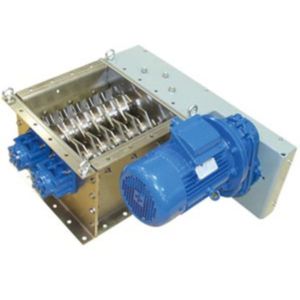
- Company
- Products
- Catalogs
- News & Trends
- Exhibitions
Food lump breaker LBC seriesbladehorizontalfor wastewater


Add to favorites
Compare this product
Characteristics
- Technology
- blade
- Orientation
- horizontal
- Product applications
- food, for wastewater
- Other characteristics
- compact, cylindrical, separating
- Sector
- for the plastics industry, for recycling
- Machine weight
Min.: 9 kg
(20 lb)Max.: 40 kg
(88 lb)
Description
The Lump Breaking Feeder Valve enables safe and smooth segregation of bulk materials that tend to pack and form lumps during production and/or storage. Its design favours gentle crushing even with hardened material under a medium-high material column.
The device consists of a solid cylindrical body with inlet and outlet flange, an integrated crushing tool driven by a side-located electric motor and a rigid grid. To adjust to the required particle size both blades and grid are easily removable to be adapted according to the desired material characteristics
The Lump Breaking Feeder Valve is fed with agglomerated solids which, after being crushed are discharged through the outlet towards further processing. The LBC is the ideal solution to break up snow-ball-like materials. It is particularly suitable for hygroscopic materials and those that are compacted under pressure, such as sugar, salt, silicates, chemicals, and food products in general. The LBC Lump Breaking Feeder Valve can be fitted in loading and/or discharging pipes, for emptying or filling drums, bins, or screw conveyors.
-Single shaft configuration
-Replaceable blades
-Easy to disassemble and clean
-Segregation without particle degradation
-Enhanced material quality
-Improved material flow
-Increased energy efficiency
-Cost-effective operation
Catalogs
No catalogs are available for this product.
See all of WAMGROUP S.p.A‘s catalogsRelated Searches
- Grinding mill
- Screening unit
- Horizontal grinding mill
- Food lump breaker
- Rotor lump breaker
- Roller grinding mill
- Knife chopper
- Recycling screening unit
- Mill for the pharmaceutical industry
- Sieving machine for the food industry
- Compact grinding mill
- Recycling grinding mill
- Stainless steel grinding mill
- Compact screening machine
- Stainless steel sieving machine
- Dry screening sieving machine
- Solid/liquid sieving machine
- Drum screening unit
- Variable speed grinding mill
- High-capacity grinding mill
*Prices are pre-tax. They exclude delivery charges and customs duties and do not include additional charges for installation or activation options. Prices are indicative only and may vary by country, with changes to the cost of raw materials and exchange rates.











